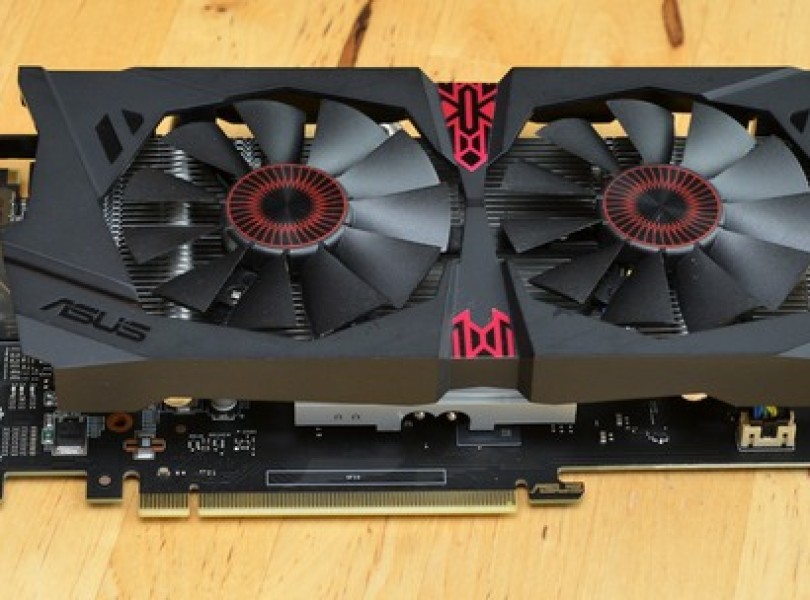[Update 8/20/15 1:00pm PT: Added overclocking data from Asus’s included software.]
Today Nvidia has launched its “sweet spot” GPU, the GTX 950. Aimed at budget gamers who want to play at 1080p, it uses a slightly neutered version of the GTX 960‘s GM206 to bring down its asking price to $160. (Some aftermarket cards will go for more; the Asus card we tested is $170.)
This of course means you won’t be able to play with your graphics settings as high on the GTX 960—but before you dismiss the 950, know that the Maxwell architecture in this particular GPU has been tweaked to reduce latency. (That’s a first.) Nvidia’s also launching a suite of sharing and recording features that let you easily stream to Twitch, save gaming footage, edit clips and upload them to YouTube, and invite other players to watch or play your game. For budget gamers who lean more toward prioritizing cash over graphics, the 950 definitely delivers solid bang for your buck.

You can check out the GTX 950’s full specs in the table below, but in a nutshell, it’s a 2GB dual-slot card that sports 768 CUDA cores and comes clocked at 1,024MHz with a boost clock of 1,188 in its stock configuration. (The Asus card we tested is clocked a bit higher, though, with a base clock of 1,165MHz and a boost clock of 1,355MHz.) It’s also shorter than the GTX 960 by a few inches, has just one six-pin PCIe power connector, and features three DisplayPorts, one DVI output, and an HDMI 2.0 port. The 950 also supports SLI.

Nvidia has tweaked the rendering pipeline in this particular GPU to reduce latency. The company says it made the optimizations in response to requests from professional MOBA players; as an example of the improvements, it showed a demo where the measurable latency of a mouse-click in DOTA 2 was decreased from 80ms on the GTX 650 to 45ms on the GTX 950.

Nvidia optimized its rendering pipeline with MOBA players in mind.
To test the Asus Strix GTX 950, we slotted it into our GPU testing rig that features an Asus Z97 motherboard, Intel Core i7-4790K CPU, and 16GB of Corsair memory. We compared the GTX 950 with the one card above it in the product stack, the $200 GTX 960, as well as the $120 GTX 750 Ti, the GTX 650 (no longer for sale), and the $150 Radeon R7 370.
| Nvidia GTX 650 | Nvidia GTX 750 Ti | Asus Strix GTX 950 | Nvidia GTX 960 | Radeon R7 370 | |
| Driver | 355.65 | 355.65 | 355.65 | 355.65 | 15.7.1 |
| 3DMark | 2139 | 4,573 | 6,050 | 6,882 | 4,179 |
| Heaven 4.0 (fps) | 13.5 | 28.4 | 35.5 | 40.2 | 21.7 |
| Batman: Arkham Origins (fps) | 31 | 50 | 62 | 73 | 42 |
| Hitman: Absolution (fps) | 16.39 | 28.84 | 36.05 | 38.6 | 28.84 |
| Metro: Last Light (fps) | 9 | 19.67 | 26.33 | 31 | 12.33 |
| Middle-earth: Shadow of Mordor (fps) | 12.8 | 31.72 | 40.84 | 46.39 | 31.74 |
| Tomb Raider (fps) | 4 | 19 | 26.8 | 31.8 | 18 |
All tests run at 1920x1080p resolution with Ultra settings and 4XAA enabled.
When examining our benchmark chart, keep in mind we enabled 4XAA. As a result, the 950 only hit 60fps once in our benchmarks, but it still was over 30fps in most; disabling AA would easily allow the card to make any game playable at Ultra settings in 1080p. That’s pretty awesome for $160 (our Asus Strix GTX 950 is an overclocked $170 model, but we don’t anticipate too much variance between it and the stock version), particularly since it beat the similarly priced AMD Radeon R7 370. The 950 is even a decent upgrade over the Maxwell-based GTX 750 Ti, and it simply destroys the much older GTX 650 in every benchmark.

Our final overclock using Asus’s software was just shy of 1.5GHz.
Like previous Maxwell GPUs we’ve tested, we found that the GTX 950 overclocks nicely. Even though the Asus Strix comes clocked higher than the stock card, it’s still noteworthy that it ran at 1,441MHz right out of the box without us having to do anything. We were then able to nudge it up even higher—we got our 950 to 1,483MHz using Asus’s included software and 1,518MHz using EVGA’s software before experiencing issues. At those clock speeds, the card never got hotter than 70°C, which is noteworthy since the higher overclock was done during a heatwave where our testing environment (a.k.a. apartment) was 90°F.
The 950’s release also marks the launch of new sharing options in Nvidia’s GeForce Experience software. There’s a new in-game overlay that you can toggle on-and-off that offers four tabs: Instant Replay, Record, Broadcast, and Stream. Some of these features used to be available through ShadowPlay, but they’ve now been rolled into this one section of GeForce Experience.
- Instant Replay: An always-on DVR for your games that will automatically record the last 20 minutes of whatever you are playing.
- Record: This will let you manually stop and start recording your gameplay.
- Broadcast: This lets you stream your gameplay to Twitch with just one click.
- Stream: This is all-new, and lets you invite a friend to watch your game or play a game for you via a PC-to-PC link. If it’s a co-op game, they can also easily also join you as a second player (even if the game only supports local co-op). Voice chat is built into this feature, eliminating the need for another service to talk with your friend.

The onscreen overlay is easily toggled on-and-off with a key combination.
Unfortunately, we weren’t able to test Share during our review of the 950, as it wasn’t yet ready. Nvidia says it should be available in the next few weeks as a public beta. We did see a press demo of it though, and it looked mighty slick, especially the co-op functions. You just click “invite” and your buddy gets the notice immediately in his or her email client. Joining the game is also a one-click affair. (If you’re familiar with the PlayStation 4’s Share Play feature, this is pretty much the same, including the 60-minute time limit per session. You don’t need to subscribe to any additional services, though.) You can also record clips and send them to YouTube, and the best part is you can edit them in the Share interface, trimming their size just by moving sliders for “start” and “stop.” It’s really cool, and gamers should dig it.
GameStream Co-Op
|
|
| Host PC | |
| GPU | GeForce GTX 650 or higher graphics card (Desktop only, notebook support coming soon) |
| GPU Driver | 355.60 or higher |
| CPU | Intel i3-2100 3.1GHz or higher |
| System Memory | 4 GB or higher |
| OS | Windows 7, 8 or 10 |
| Router | Minimum: 802.11 a/g router Recommended: 802.11n 5GHz router or Ethernet |
| Network | Recommended upstream bandwidth: 7Mbps |
| Games | DirectX 9 or higher games running in fullscreen mode |
| Guest PC | |
| GPU | No minimum requirement |
| CPU | Intel i3-2100 3.1GHz or higher |
| System Memory | 4 GB or higher |
| Software | Chrome 44 |
| OS | Windows 7, 8 or 10 |
| Router | Minimum: 802.11 a/g router Recommended: 802.11n 5GHz router or Ethernet |
| Network | Recommended downstream bandwidth: 7Mbps |


